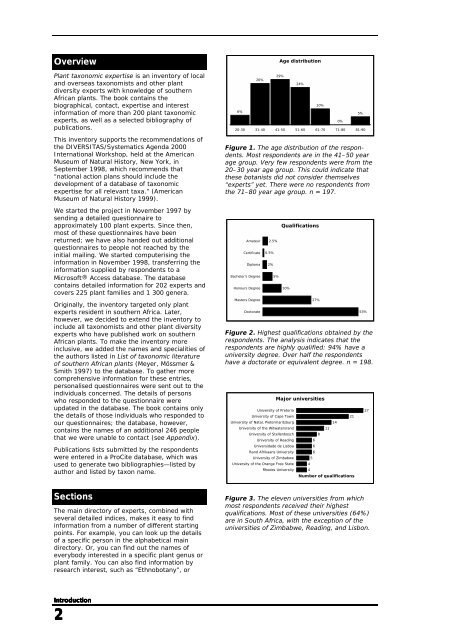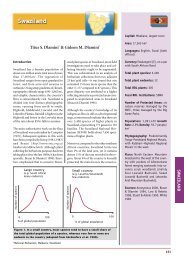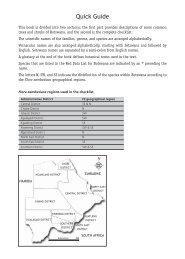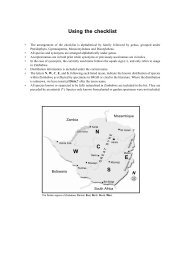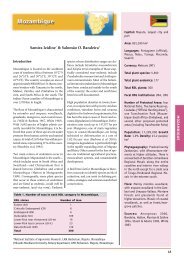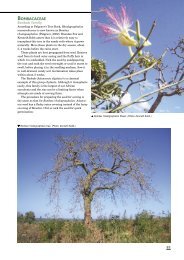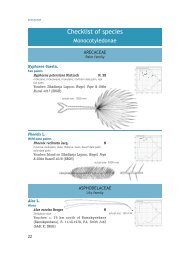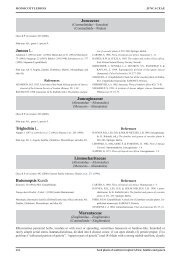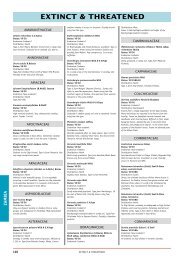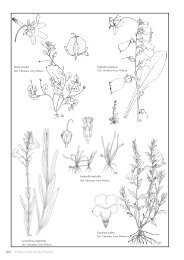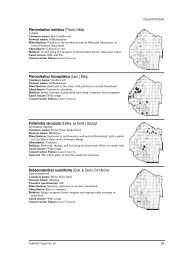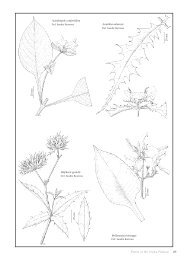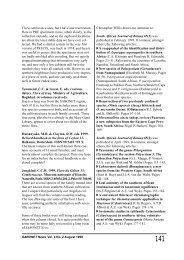Plant taxonomic expertise - SABONET
Plant taxonomic expertise - SABONET
Plant taxonomic expertise - SABONET
Create successful ePaper yourself
Turn your PDF publications into a flip-book with our unique Google optimized e-Paper software.
Overview<br />
<strong>Plant</strong> <strong>taxonomic</strong> <strong>expertise</strong> is an inventory of local<br />
and overseas taxonomists and other plant<br />
diversity experts with knowledge of southern<br />
African plants. The book contains the<br />
biographical, contact, <strong>expertise</strong> and interest<br />
information of more than 200 plant <strong>taxonomic</strong><br />
experts, as well as a selected bibliography of<br />
publications.<br />
This inventory supports the recommendations of<br />
the DIVERSITAS/Systematics Agenda 2000<br />
International Workshop, held at the American<br />
Museum of Natural History, New York, in<br />
September 1998, which recommends that<br />
“national action plans should include the<br />
development of a database of <strong>taxonomic</strong><br />
<strong>expertise</strong> for all relevant taxa.” (American<br />
Museum of Natural History 1999).<br />
We started the project in November 1997 by<br />
sending a detailed questionnaire to<br />
approximately 100 plant experts. Since then,<br />
most of these questionnaires have been<br />
returned; we have also handed out additional<br />
questionnaires to people not reached by the<br />
initial mailing. We started computerising the<br />
information in November 1998, transferring the<br />
information supplied by respondents to a<br />
Microsoft® Access database. The database<br />
contains detailed information for 202 experts and<br />
covers 225 plant families and 1 300 genera.<br />
Originally, the inventory targeted only plant<br />
experts resident in southern Africa. Later,<br />
however, we decided to extend the inventory to<br />
include all taxonomists and other plant diversity<br />
experts who have published work on southern<br />
African plants. To make the inventory more<br />
inclusive, we added the names and specialities of<br />
the authors listed in List of <strong>taxonomic</strong> literature<br />
of southern African plants (Meyer, Mössmer &<br />
Smith 1997) to the database. To gather more<br />
comprehensive information for these entries,<br />
personalised questionnaires were sent out to the<br />
individuals concerned. The details of persons<br />
who responded to the questionnaire were<br />
updated in the database. The book contains only<br />
the details of those individuals who responded to<br />
our questionnaires; the database, however,<br />
contains the names of an additional 246 people<br />
that we were unable to contact (see Appendix).<br />
Publications lists submitted by the respondents<br />
were entered in a ProCite database, which was<br />
used to generate two bibliographies—listed by<br />
author and listed by taxon name.<br />
Sections<br />
The main directory of experts, combined with<br />
several detailed indices, makes it easy to find<br />
information from a number of different starting<br />
points. For example, you can look up the details<br />
of a specific person in the alphabetical main<br />
directory. Or, you can find out the names of<br />
everybody interested in a specific plant genus or<br />
plant family. You can also find information by<br />
research interest, such as “Ethnobotany”, or<br />
Introduction<br />
Introduction<br />
Introduction<br />
2<br />
6%<br />
26%<br />
Age distribution<br />
29%<br />
24%<br />
10%<br />
20-30 31-40 41-50 51-60 61-70 71-80 81-90<br />
Figure 1. The age distribution of the respondents.<br />
Most respondents are in the 41–50 year<br />
age group. Very few respondents were from the<br />
20–30 year age group. This could indicate that<br />
these botanists did not consider themselves<br />
“experts” yet. There were no respondents from<br />
the 71–80 year age group. n = 197.<br />
Amateur<br />
Certificate<br />
Diploma<br />
Bachelor's Degree<br />
Honours Degree<br />
Masters Degree<br />
Doctorate<br />
2.5%<br />
0.5%<br />
2%<br />
5%<br />
Qualifications<br />
10%<br />
27%<br />
0%<br />
5%<br />
53%<br />
Figure 2. Highest qualifications obtained by the<br />
respondents. The analysis indicates that the<br />
respondents are highly qualified: 94% have a<br />
university degree. Over half the respondents<br />
have a doctorate or equivalent degree. n = 198.<br />
University of Pretoria<br />
University of Cape Town<br />
University of Natal, Pietermaritzburg<br />
University of the Witwatersrand<br />
University of Stellenbosch<br />
University of Reading<br />
Universidade de Lisboa<br />
Rand Afrikaans University<br />
University of Zimbabwe<br />
University of the Orange Free State<br />
Major universities<br />
Rhodes University<br />
8<br />
6<br />
6<br />
6<br />
5<br />
4<br />
4<br />
11<br />
14<br />
21<br />
Number of qualifications<br />
Figure 3. The eleven universities from which<br />
most respondents received their highest<br />
qualifications. Most of these universities (64%)<br />
are in South Africa, with the exception of the<br />
universities of Zimbabwe, Reading, and Lisbon.<br />
27


